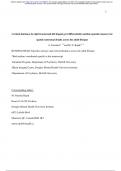Tentamen (uitwerkingen)
Cortical thickness in right frontal and left lingual gyri differentially mediate episodic memory for spatial contextual details across the adult lifespan
- Vak
- Instelling
Cortical thickness in right frontal and left lingual gyri differentially mediate episodic memory for spatial contextual details across the adult lifespan A. Swierkot* 1, 2and M. N. Rajah*2,3 RUNNING HEAD: Episodic memory and cortical thickness across the adult lifespan *Both authors contrib...
[Meer zien]




